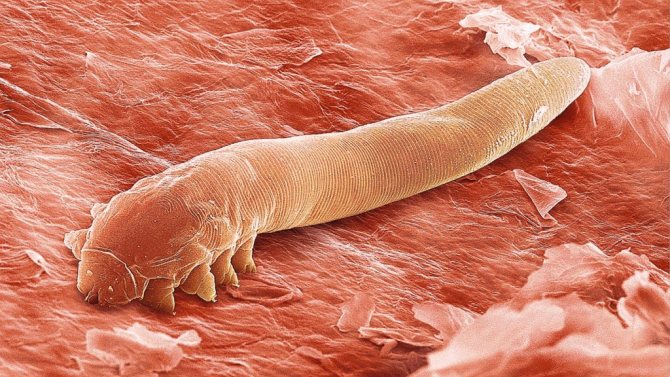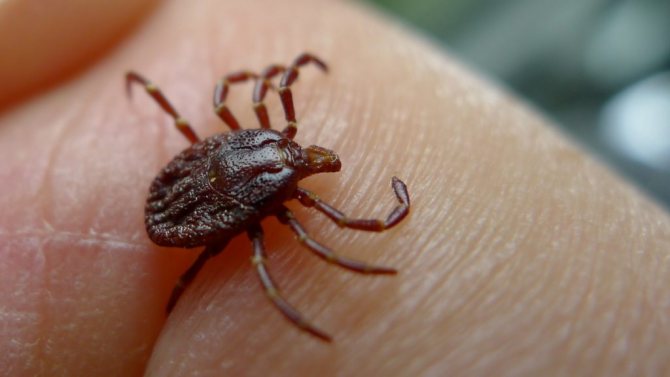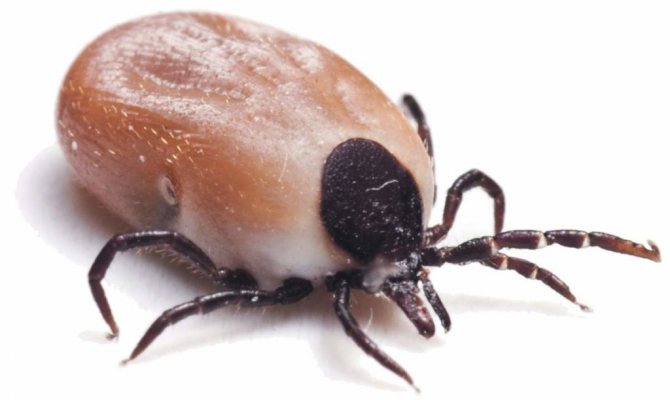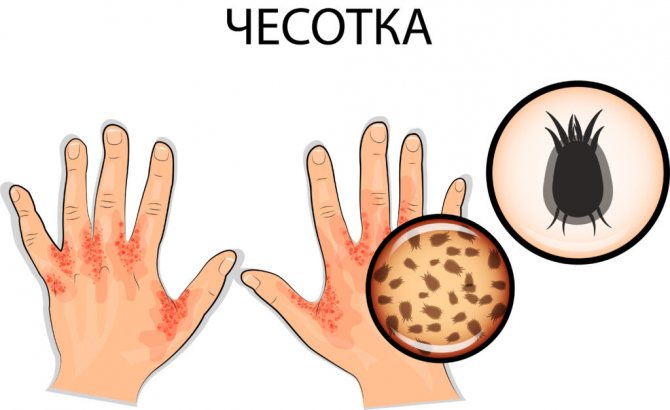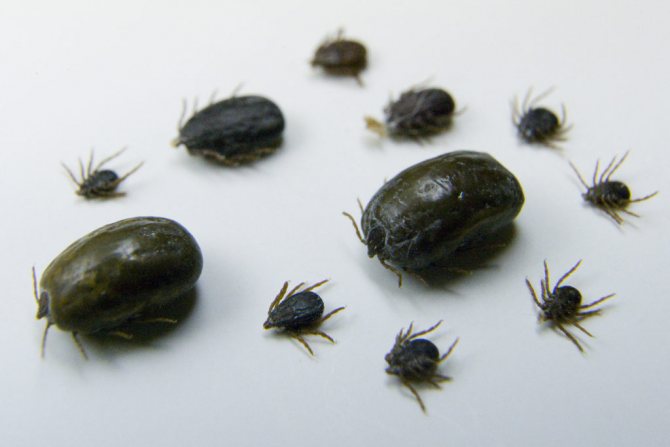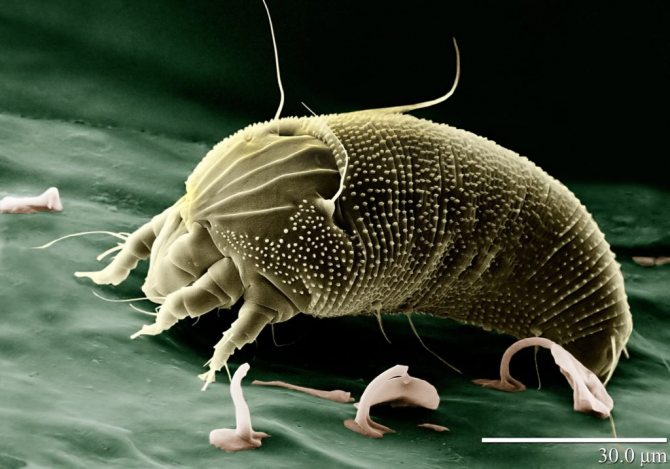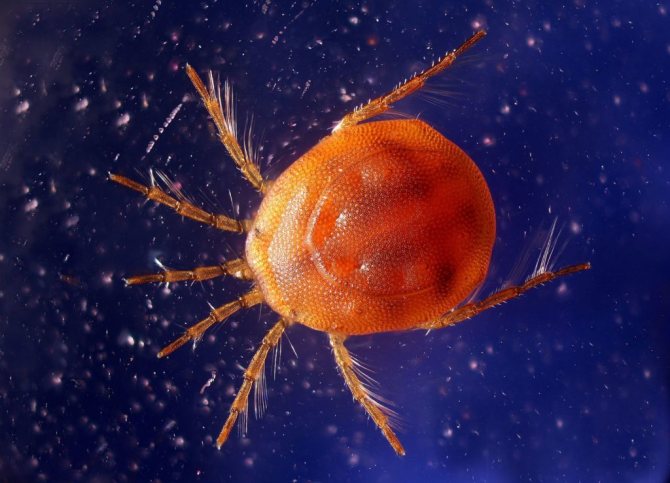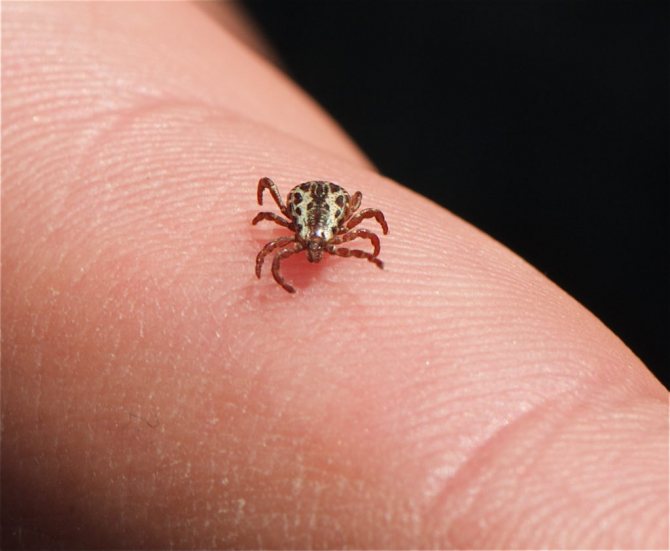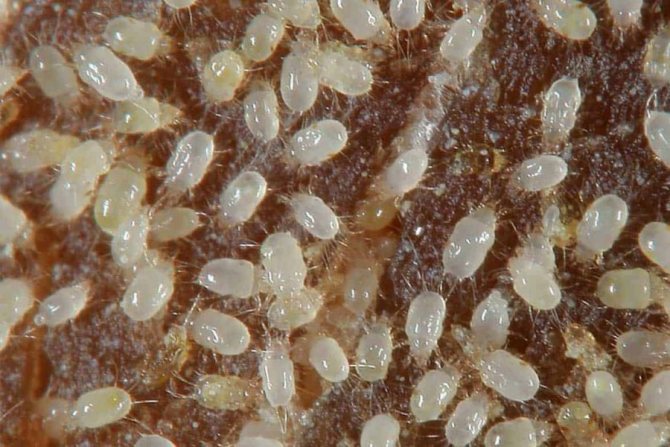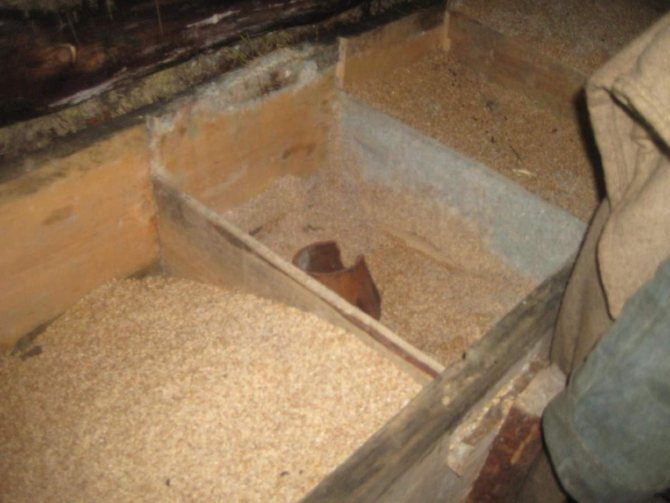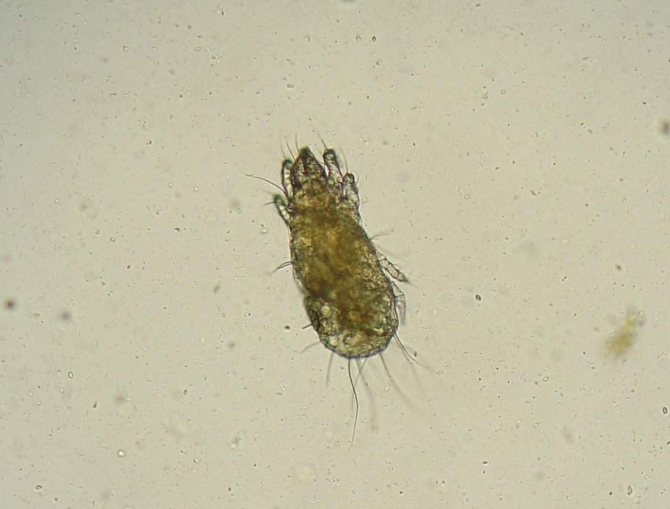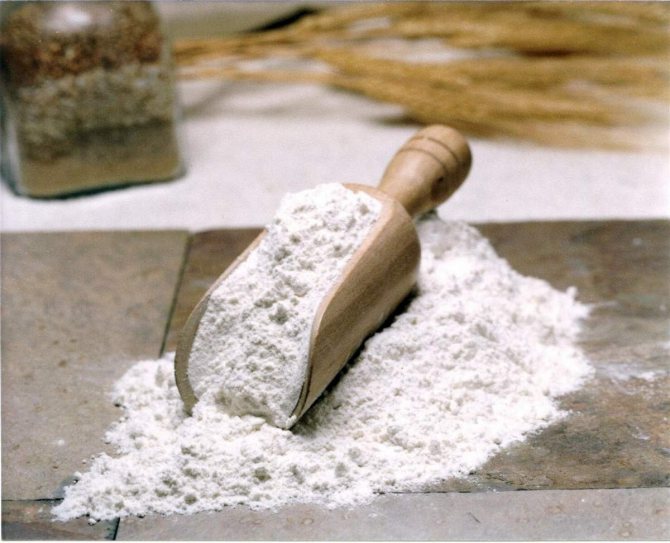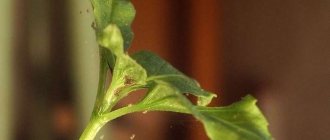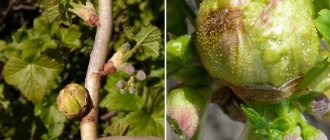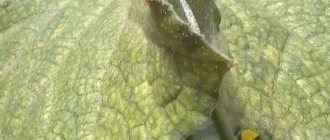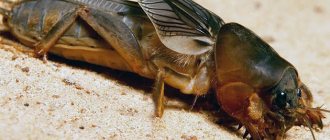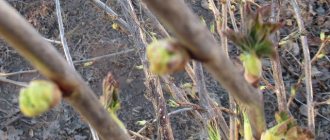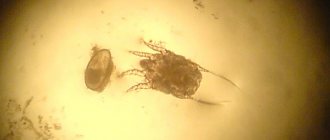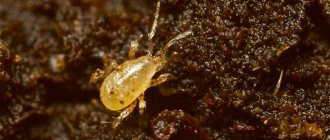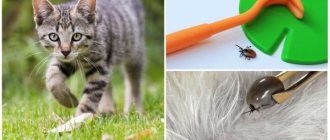Tick appearance
Scientists call barn or tyroglyphoid mites chewing, they got this name because of the specific structure of the pincers with which they bite off their food. It is difficult to detect parasites with the naked eye, they are very small, they can only be examined under a microscope. You can recognize them by the following features:
- the tick is small, only 0.2-0.5 mm long;
- the body is oval, whitish in color, translucent;
- four pairs of legs.
A distinctive feature of the pest is its simplest structure, it does not have complex organs. The tick breathes with its entire body through the spiracles on the skin, which cracks at low humidity, and the pest dies.
Important!
It can be difficult to determine that a product is infected with a tick; this can be diagnosed in different ways. The most effective trick is the use of double-sided tape, it is glued to the door of the food locker, and after a day they are checked, several parasites will still be caught.
Barn mite
There are variants of mites with a slightly reddish, almost rusty color, they are better seen on flour.
A brief introduction
These are very small creatures, hardly distinguishable by the naked eye: the length of their body is from 0.2 to 0.5 mm. The barn mite has an oval body with a smooth and thin, whitish shell that is almost transparent. Through it you can see the fat reserves accumulated by the arthropod in the process of life. Against the background of a light body in most species, dark legs and jaws are clearly distinguished under a microscope.
Barn mites are known primarily as malevolent pests that live in and destroy human supplies. The scale of infection can be different: arthropods settle in huge elevators and in cans of flour in an ordinary kitchen.
Life forms
The life forms of barn mites are absolutely identical with the developmental stages of other pests of this species. The development path from egg to adult takes about two weeks under favorable conditions. The barn mite has the following main stages of development:
- The first stage is the egg laid by the female. Its shape can be varied, and the colors are different. However, the size is always small, up to 0.13 mm long. In this state, the future tick is not for long, only 3-4 days.
- A larva hatches from the egg, its size fully corresponds to the size of the egg and no more than a poppy seed. She already has three pairs of limbs, she is actively feeding and is gradually gaining in size. The larva undergoes two molts, but it does not yet have setae and a harder body shell.
- After a couple of days of such existence, the larva becomes a 1st instar nymph. The lifespan of this life form is about a week, during this period another pair of limbs grows in the tick, it changes, takes the form of an adult pest.
- After a couple of molts, the nymph from the 1st instar passes into the second. This is already a fully adult arthropod, which has a gender and actively feeds, and then mates and lays eggs.
The barn mite differs from its mite counterparts by another life cycle, the hypopus. It occurs under unfavorable conditions for life in the interval between the 1st and 2nd age nymphs. The pest becomes covered with a dense shell, they do not feed at all, as if they freeze.Such fading can last long enough, then an adult creature hatches from the cocoon, which can leave behind offspring.
Harm done
If for a long period nothing is done to reduce the number of barn mites, they will completely spoil the entire stock of food that is at home or in a warehouse. At home, with small volumes of stocks, it does not look so scary, throwing away a few pounds of groceries with ticks is cheaper than treating the poisoning later. But on a warehouse scale, things look different.
That is why, in the period when warehouses and elevators are completely freed from products, disinfestation is necessarily carried out with chemical preparations of weak action that cannot harm the human body.
The barn mite is a food pest for humans, it is imperative to fight it.
The barn mite is a small arthropod that can take a fancy not only to rooms where grain and flour are stored, but also kitchen cabinets, where these creatures can find a sufficient amount of food. It is not particularly difficult to remove these parasites at home. To combat them, you can use conventional detergents.
In houses and apartments, it is quite possible to eliminate the factors that contribute to the increase in the number of these creatures. In large areas, barn mites are much more difficult to deal with. In this case, complex preparation of premises for storing crops that are attractive to these arthropods is often required, as well as additional processing of cereals if there are signs of infection.
Control methods
Means of combating flour mites can be divided into physical and mechanical and chemical.
Physical and mechanical include:
- Cooling of grain or its products. At 5 degrees below 0, the pest dies.
- Heating contaminated food above 55 degrees.
- Mechanical cleaning will help reduce the level of infection.
For chemical pest control, the following are used:
- preparations with hydrogen phosphide in the composition;
- contact insecticides;
- sulfur preparations.
The contaminated product is subjected to gas disinfestation or spraying, depending on the degree of infection and the volume of the room. Chemical methods are not advisable to apply in room conditions: they are designed for processing large quantities of grain. At home, it is better to do with calcining or freezing; Throw away products with obvious signs of contamination.
Anatomy and lifestyle of barn mites
Currently, more than 200 varieties of these creatures are known. Barn mites are arachnids. The body of an adult is about 0.3-0.5 mm. The body is oval in shape. The body has a pronounced segmentation, including the head and abdomen. The outer cover is glossy. It contains a significant supply of adipose tissue. These creatures have no eyes. The body is usually beige or white in color. The paws are darker. Barn mites are extremely primitive creatures.
They absorb oxygen throughout the body, since they do not have spiracles. Antennae that help other arthropods to learn about the world, these creatures also do not have.
Adults live no more than 2-3 months in the summer. During this time, the female can lay about 200 eggs. After hatching, the larvae have 6 pairs of legs, they can actively move to search for food. After the first transformation, the nymph already has 8 legs. At the third reincarnation, the barn mite begins to look very much like an adult.
These creatures prefer:
- flax seeds;
- wheat grains;
- legumes;
- flour;
- dried fruits;
- cheeses;
- corn.
Under certain circumstances, other crops may also be included in the diet of barn mites. Preferred for these creatures are grains rich in vegetable fats.The main feature of barn mites is the ability of a second-instar nymph to degenerate into an intermediate waiting stage, which is called hypotus. In this form, the arthropod is reliably protected by a carapace that is resistant to many adverse environmental factors. While in this state, the nymph does not feed and does not grow. It uses up the reserves accumulated earlier. The nymph leaves its protective shell when favorable conditions are created for this.
For growth, development and reproduction, these creatures require not only an optimal breeding environment, but also a certain level of moisture. Barn mites, despite their name, are extremely common in nature; they are often found on various root crops, in the soil, on plant bulbs, as well as in mammalian burrows and bird nests. Here they can find a sufficient amount of food for themselves, but at the same time there are certain restrictions that significantly inhibit their reproduction. In the premises created for storing grain, where there are favorable conditions, nothing holds back the growth of their number.
Summing up
Summing up all of the above, we can say that this parasite is very dangerous for humans and you need to get rid of it as quickly as possible. Remember that special conditions are required for their reproduction, humidity is especially important, so exclude this factor in the room. Maintain cleanliness and use safe traditional methods. Don't forget about preventive actions, which are very important.
If the bugs started up, and you could not cope with them on your own, the right thing in this case would be to contact specialized services.
What harm do barn mites do?
These arthropods, with their extremely small size, can easily be brought into grain storage facilities, from the fields during harvest, or with contaminated items. Rodents often contribute to their spread. In the event that barn mites were brought to an elevator or barn for long-term storage of grain, and at the same time favorable conditions are created, including air humidity exceeding 13%, these creatures begin to multiply rapidly.
In some cases, when favorable conditions are created for this, the number of barn mites increases so much that if you look closely, you can see how the grain moves due to the movement of these creatures. With such a strong infestation, cereal crops are severely damaged, which reduces their value. In this case, the grain becomes unsuitable for sowing, since its germination capacity will be minimal.
In the process of vital activity, ticks excrete a large amount of feces. In addition, the grain is clogged with the shells of dead arthropods. This causes the grains to clump together. In most cases, this leads to impaired ventilation of the grains, overheating and rotting. With a significant increase in barn mites, all food stored in the room can be completely destroyed. If barn mites are swallowed by humans, allergic reactions and intestinal disorders can occur. In addition, the aspiration of these creatures into the lungs of a person can provoke a severe asthma attack.
Thus, eating foods contaminated with these arthropods is not recommended even after thoroughly cooking. Currently, there are no effective ways to prevent these creatures from entering the premises where crop products are stored. If you take certain measures, you can significantly reduce the risk of contamination of cereals by these arthropods.
Why are ticks dangerous?
Many people remember stories from childhood, when they were bitten by a tick and they just got it. In this regard, not everyone knows that they are very lucky. If you catch a tick - this is not only an annoying incident, but also deadly.The tick crawls under the skin and sucks blood. That at best leads to itching and burning, and at worst - fatal diseases: borreliosis, encephalitis, spotted fever, relapsing fever, epilepsy, pneumonia, paralysis and others. Symptoms of diseases in the initial stages, by and large, do not differ from ordinary diseases or bites of other numerous representatives of the fauna: fever, redness of the bitten area, itching and burning, chills, aches, swelling. Sometimes the bite is accompanied by headaches, nausea, and even hallucinations. Therefore, after each visit to their intended habitat, inspect the body for bites.
Do not go into the forest in open clothes and protect yourself with various repellents, of which there are a huge number of stores now. If you often relax in nature, then it is better to go to vaccinations at all, carried out in medical institutions.
If it so happens that the tick has bitten you, then it is best to consult a doctor right away. If this is not possible, then you can try to get it yourself. This should be done as carefully as possible, the body of the tick is easily separated from the head, and if it remains, it is much more difficult to remove it yourself. Ticks are removed with a thread or tweezers. Gently pull out the carcass with gentle circular motions. Make sure the head pops out exactly.
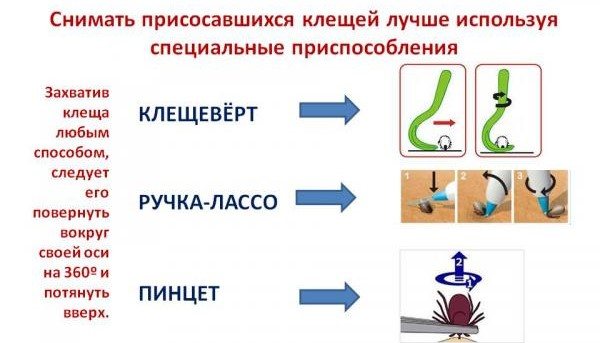
In no case do not throw it away after that. It must be taken to a research laboratory to check whether it is encephalitic. If you are bitten by such a tick, then you need to see a doctor for therapy. In the event that, after a tick bite, a person is paralyzed, it is necessary to immediately call an ambulance without fail. No independent action can be taken.
Measures to control barn mites in storage facilities
Considering that these creatures live on cereals that are eaten by humans and animals, it is not recommended to use various chemical agents to eliminate arthropods, as this will significantly reduce the quality or make the resulting crop unusable. In order to avoid crop losses due to barn mites, it is very important to properly prepare the premises for the reception of cereals and create conditions there that will prevent mites from multiplying. First of all, the room must be thoroughly ventilated and cleaned of dust. All cracks in the floor and walls should be treated with special insecticides and then plastered. Among other things, when storing a large volume of grain, it is advisable to arrange a ventilation system. A certain temperature and relatively low air humidity will become a serious obstacle to the life and reproduction of the barn mite.
In some cases, when there are already signs of grain mite infestation, it is advisable to decontaminate it in a dryer. Adults and juveniles die at 50 ° C in just 20 minutes. If desired, the processing time can be reduced to 10 minutes. However, in this case, the heating temperature of the grain must reach 60 ° C.
To eliminate ticks on large farms, it is recommended to have a high-quality grain cleaning machine that will remove more than 90% of pests. Freezing of grain can give a certain effect, but this will significantly affect its germination.
As a last resort in the fight against mites, aeration of grain is used. For such procedures, highly volatile poisonous liquids are usually used. The resulting gas during evaporation is much heavier than air and quickly penetrates into the grain. These include methyl bromide and metal chloride. After processing with such potent poisons, long-term ventilation of the grain is required before selling.It is necessary to use such funds, strictly following the instructions attached to them.
recommended products
Bestseller
Medilis-CIPER against mosquitoes, bedbugs and ticks (insectoacaricide) Concentrate against ticks, mosquitoes, bedbugs, cockroaches, ants, etc. More ...


Medilis-SUPER (insectoacaricide) (500 ml bottle, corrugated box, 20) Concentrate against synanthropic, as well as for treating the territory from mosquitoes, midges and ticks. Read more ...
Medilis-PERMIFEN (insectoacaricide) (bottle 500 ml, Corrugated box, 20) Concentrate against synanthropic (bugs, cockroaches, ants, fleas, etc.) More ...
How to get rid of barn mites at home?
These unpleasant arthropods can also start in a dwelling where there is high humidity, which is not uncommon for apartment buildings. Barn mites can be brought into a house or apartment along with infected crops. Thus, in order to reduce the risk of contamination of the living quarters, when buying products, you need to pay attention to the fact that there is no flickering in the cereals, and the packaging itself is not damaged.
Improper storage of cereals significantly predisposes to the reproduction of these creatures. If favorable conditions are created in the living room and there is a certain level of humidity, you can notice how mites are spread from the open container in which the cereals are stored. When signs of damage to the grains stored in kitchen cabinets appear, it is necessary to begin to take active steps to eliminate them, since the presence of these creatures in the room can adversely affect human health.
First of all, it is necessary to carefully throw away all the cereals, and not only those that have obvious signs, but also those that were just lying nearby. Next, you need to carry out a thorough sanitization of all kitchen cabinets where the grain was stored. It is very important to thoroughly lather all surfaces so that the detergent can penetrate even the deepest cracks. You can use a vacuum cleaner to clean the corners to be sure to remove any crumbs that might harbor barn mites.
It is advisable to fully sanitize the kitchen using modern detergents in order to minimize the risk of re-infestation of the contents of kitchen cabinets by these arthropods. It is necessary to purchase sealed or simply tightly closed containers for storing cereals. This will avoid contamination of food in the future. It is quite easy to get rid of barn mites in a small living space. In order for them not to appear again, it is necessary to periodically carry out a thorough wet cleaning of the room.
Where does the pest live
The habitat of the flour mite can be different. He is often met in residential premises, at a mill, flour mill, bakeries, shops, warehouses. In addition, it thrives in soil, haystacks, mole and mouse burrows.
The most favorable temperature for a flour mite is 22-24 °. Under these conditions, the female actively mates with the male. After a few days, she can already lay eggs (3-4 pieces per day). The offspring, as a rule, reproduce close to those places where there is food.
The temperature regime at which the female cannot lay eggs is more than 30 ° and less than 8 °.
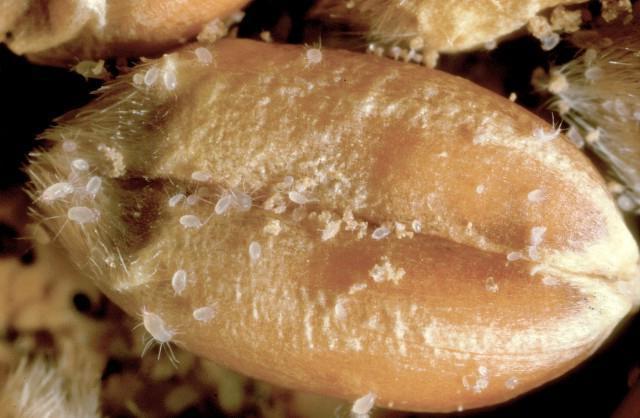

Bread mite
Pediculoides graminum Reit.
Bread mite, Grain mite, Siteroptes graminum Reut., Siteroptes cerealium
The bread mite is a microscopic amber-colored arthropod. Pest of cereals.
It is also found in the grain mass, since it is a field pest of plants and enters the granary with freshly harvested grain, but soon dies of hunger, since it is not able to feed on solid grain.
Morphology
Imago. The body of the female is from amber to light orange, elongated, segmented, 0.20-0.25 mm long.The fixed finger is sickle chelicerae; a pair of pseudostigmal organs on the protersome. The body length of a pregnant female reaches 2 mm, and the color of the opisthosoma is whitish.
The male is slightly smaller than the female, has no pseudostigmal organs. Does not feed in adulthood; the oral apparatus is reduced, the posterior intestine and anus are absent.
The larva is six-legged.
Development
Fertilized females overwinter in the stubble behind the leaf sheaths of cereals. Young stems are activated and populated in spring at an air temperature of 13-15 ° C. The development of embryos occurs in the body of the female, and their number ranges from 1000 to 500.
Having established themselves in their habitats, the females gradually increase in volume and after 5-10 days they start ovoviviparity, which lasts 2-5 days. From the laid eggs, larvae hatch within a few minutes, which, after a period of active life (1-2 days) and then a period of rest (2-4 days), turn into adult ticks.
At first, the female lays eggs or gives birth to single larvae, later, however, the integument of the abdomen is torn, and the entire mass of the larvae, having completed development inside her body, comes out. The female dies in this case.
Among them there are males, already fertilized females and nymphs.
According to the observations of M.I. Ovchinnikova (1938), the most favorable conditions for tick reproduction in the Moscow region are moderate temperatures and high humidity. Therefore, mites concentrate on grasses in ditches, field edges, bushes and other irregularly mown areas.
In the countries of Central Europe, 4-5 generations develop per season.
Harmfulness
Oligophage. Can feed on barley, wheat, rye, oats, corn, cereals. From plants of other families, it is noted on carnation.
Due to their tendency to moderate temperatures and high humidity, bread mites concentrate on grasses in ditches, field edges, bushes and other irregularly mown areas. Seeds of cereal grasses in floodplains are also often affected.
On young cereals, it causes wilting of the central leaf (similar damage is caused by the Swedish fly) or of the entire shoot; on older plants, spiral twisting occurs in the upper node of the spikelet and partial or complete hairlessness.
Of the cereal grasses, the grain mite most severely damages red fescue, bluegrass and bent grass, weaker - meadow fescue, pasture and Westerwold ryegrass.
What is it: features and development cycle
The flour mite (also called the barn mite, Acarus siro) is an arthropod, one of the types of acariform mites. It is a dangerous pest not only of grain, but also of any grain products. Despite the fact that not many people know about it, it belongs to the synanthropic arachnids. Often settles in kitchens, where he chooses warm and dark corners for breeding, perfectly adapts to unfavorable conditions. The main source of nutrients is the change of cereals. It can eat flour and any flour products, for example, bread. In the absence of cereals, it can "switch" to grass or sunflower seeds. He eats with pleasure dried fruits or vegetables, milk and even cheese or meat products.


Flour mites are microscopic in size: no more than 0.7 mm in length. The body is oval, translucent. They migrate with the wind or rodents. They can get into the room with dust on shoes or clothes. The most comfortable living environment is dark, humid rooms (65% to 80%) with temperatures from 21 to 27 degrees. Once in favorable conditions, barn mites begin to multiply vigorously.
The pest's maturation is preceded by several stages: an egg, a larva, a nymph. The first one lasts about 6 days.An adult female tick bears eggs for several days, then lays them in a secluded place so that nutrients are nearby. The larva that emerged from the egg does not look like a sexually mature pest and has three pairs of legs. After molting, her body transforms, but still has an underdeveloped appearance. In the state of a nymph, the tick is able to remain until favorable conditions occur. If there is enough food, and the humidity and temperature are within the normal range, after a few days the nymph sheds again, turning into an adult, ready for reproduction. During 2-3 months of life, the female lays up to one and a half hundred eggs.
Pest signs
- It is almost impossible to detect a flour mite as soon as it appears, and this is due to the fact that it is very small in size and is well camouflaged in food supplies. As can be understood from the name of the tick, the first thing to look for is in flour. In addition, there are several signs that will help identify the parasite.
- The first thing to look out for is the smell. Where they live, a rather specific smell appears, it resembles the scent of mint. If you notice that, for example, flour or cereals have an unnatural smell for the product, then most likely they are infected with a tick. Also, the products change their taste characteristics, a sweetish aftertaste appears.
- In addition to smell and taste, we can identify them visually. It is necessary to take a good look at flour products and cereals. If a bug starts up, but something similar to a plaque in the form of small grains of sand appears on them. To identify the parasite in flour, you can do the following: Pour a little flour on the table, and spread over the surface in a thin layer, leave for 20 minutes. If there are noticeable small bumps on the surface of the flour, then there is a mite in it.
- Another way we can detect flour mites is with scotch tape. We take double-sided tape and glue it on the doors of the cabinet where food supplies are stored. A few days later we take a magnifying glass and look at the tape, if you have this parasite, you will see it.
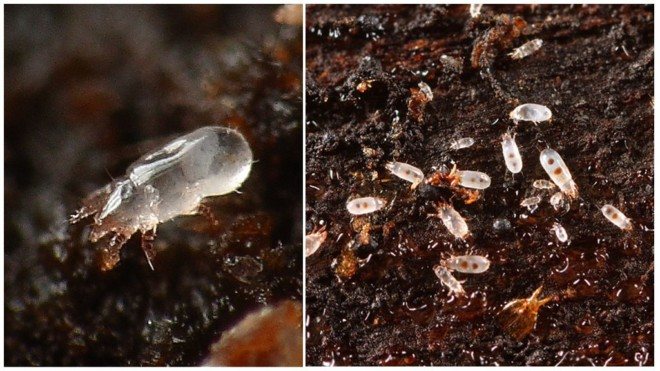

Danger and harm done
The barn mite got its nickname for a reason. Most often it can be found in barns and warehouses, and from there it spreads to kitchens. The pest is easily adaptable and is able to "wait out" long periods of lack of food. Over time, he gets into homemade preparations.
Grain eaten by mites, like other foods, is dangerous for processing and eating. May cause unexpected allergic reactions, rendering the human or animal body hypersensitive to allergens. Chitinous membranes left after molting provoke skin allergies, or flour scabies, which is especially acute in children. In addition, hazardous bacteria and infections, such as E. coli, are present in the waste products of ticks. Among the consequences of eating food spoiled by ticks are various diseases of the gastrointestinal tract, liver and kidney diseases.


A flour mite is easily detected: a layer of flour is scattered on the table, leveled with a hand or a spoon. If after a while the smooth surface becomes loose, a pest has settled in the flour. There are other signs: a bitter taste, a slight mint smell, and a grayish tinge.
Development features
The flour mite is found all over the world. In its natural environment, it lives in plant litter, hay harvesting. With pleasure he settles in livestock buildings, in fields with legumes, corn, cereals. It enters the granaries with the harvested crop, in inventory, equipment, containers. The speed of movement of a flour mite is 12 cm per hour, so it is not capable of covering kilometers by itself.
The survival rate of arachnids is quite high.At subzero temperatures up to 5 ° C, larval forms, nymphs, adults are able to live for 2 weeks, and eggs remain viable for up to six months. At temperatures from + 60 ° C, they die within 5 minutes. Temperature indicators optimal for development are in the range of + 20-27 ° С.
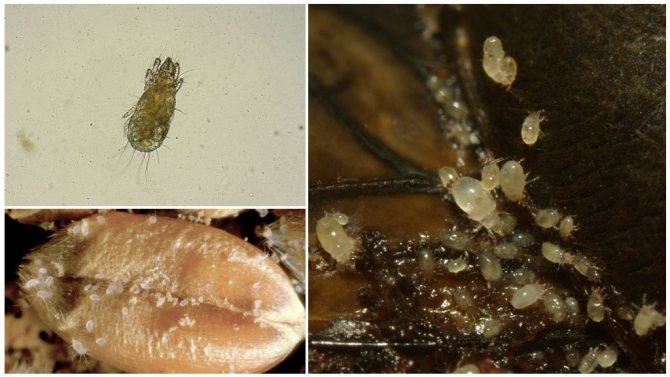

Flour mite
On a note!
A more important factor in the life of flour mites is moisture. Comfortable air humidity 80%, minimum threshold 60-65%.
Prevention measures
Prevention will help prevent the appearance of a flour mite. It is especially important for large storage facilities, because during the winter the flour mite is able to eat up the embryos from half of all the grains. The spoiled seeds will be unable to germinate and produce the next crop. They cannot even be used to make flour.
For large enterprises, preventive measures should include:
- Inspection of warehouses for the presence of a pest.
- Regular insecticide treatments of grain transport containers.
- Preparation of granaries before placing grain. Assumes cleaning and full wet pest control.
- Preparation of the grain itself: drying, cleaning from impurities.
- Processing of grain ready for storage with contact insecticides.
- Storage of grain and products from it at low temperatures; maintaining uncomfortable moisture for the flour mite.
- Regular movement of grain layers and ventilation of premises.
- Regular examinations for the appearance of the pest.


To prevent the flour mite from appearing in the house or apartment, it is enough to follow the following rules:
- Do not purchase or bring flour of dubious quality into the house: grayish, with an unusual smell.
- Be wary of flour and other discounted products.
- Buy stocks of cereals and flour in small portions, store them in a clean sealed container.
- Store food for humans and animals (especially dry food) in different places.
- Regularly ventilate and rinse pantries with insecticidal solutions.
- Products that are especially susceptible to mite infestation (grain and bone flour, cereals, herbs, dried fruits) should be regularly dried.
- Carry out in the cold or warm up flour, cereals and other food supplies that are subject to long-term storage.
At home, you can scare off a flour mite with herbal products. Does not tolerate the pest of the smell of garlic. Therefore, they put a clove in a container with flour or cereals. You can use bay leaves for the same purpose. Meal mite contaminated food can be a serious health threat. Therefore, it is important to always monitor the quality of flour, dried fruits and cereals; at the slightest suspicion of the presence of a pest, the infected products are thrown away or burned.
The parasite was found, further steps to destroy it
If a flour mite has been found, the fight against it should be started immediately.
To begin with, you need to carefully put all the spoiled food in a garbage bag and take it to the tank away from home. Don't forget to clean up the closet. The surest way is a vinegar solution. Then dry the shelf thoroughly with a hairdryer. Be careful not to leave debris or crumbs in corners and crevices. To do this, use a vacuum cleaner.
Another important detail is the processing of cans and containers in which food and groceries infected with flour mites were stored. They need to be washed well with warm water, it is better to heat them up after that and dry them thoroughly. Only then can they be used.
The flour mite is not dangerous to humans. But in some cases, when ingested with food, allergic reactions may occur, up to loss of consciousness and respiratory arrest.
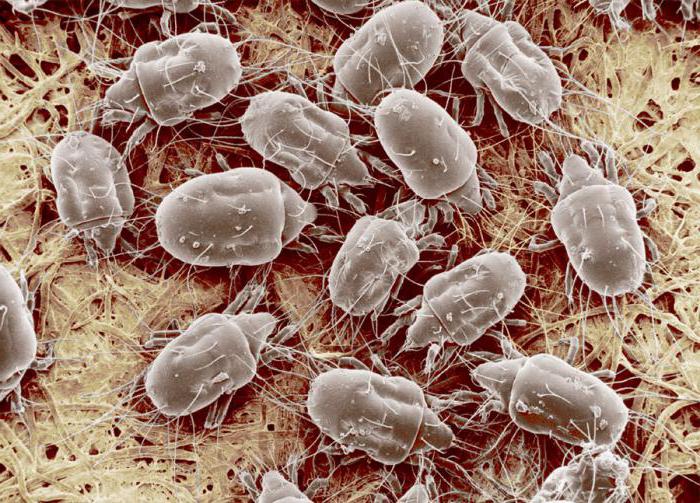

The life of a barn mite
Barn mites, although they prefer to feed on the results of human labor, are widespread in the wild. They have mastered a variety of biotopes. The habitat of the barn mite can be tree sap, rotten stumps, moss and lichen.Some of the species live in bulbous and root plants. Rodent minks and bird nests also suffer from ticks. The ideal conditions for life and active reproduction of all barn mites are high air humidity, adequate oxygen supply, and protection from direct sunlight. All ticks have a rather primitive structure and lack complex organs. These arthropods breathe with the entire surface of the body through the spiracles. It is for this reason that their body has a thin membrane that is sensitive to air humidity: when it is too dry, the surface of the mite's body dries up and cracks.
Females have a short lifespan: up to 3 months in summer and six months in winter. Despite their short existence, each of them manages to lay up to 200 eggs.
Barn mites differ from their closest relatives by the presence of a special phase in the development cycle - the hypopus. An adult turns into it if environmental conditions are unfavorable. The hypopus is covered with a hard protective shell. As soon as the situation improves, the tick turns into a nymph again.
Barn mites feed mainly on plant foods. They prefer foods that are high in fat. Their ability to cope with adverse conditions and their ability to reproduce rapidly increases the population rapidly. Therefore, if ticks are bred in the products, it will not go unnoticed.
What are ticks
The varieties of ticks are subdivided into groups: parasitiform, acarimorphic and haymaking. Hay mites do not include many species in their group. These are the largest representatives of the detachment, but they are quite rare. Their habitat is forest, tropics. They lead a hidden lifestyle and are located in hard-to-reach places.
Parasitiform ticks are the most dangerous and pose the greatest threat to animals and humans. Representatives of this species jump on a person and suck blood. It is this species that carries various viruses dangerous to humans. The season of their activity is from May to September. The habitat is very wide and they are found even in countries with cold climates.
Acarimorph mites are the largest group. It accounts for 30 thousand varieties. This group includes both predatory parasites and saprophages.
Harm
Different types of barn mites harm certain foods. For example, there are pests:
- stocks of grain and products made from it;
- bulbous plants;
- cheese;
- wine;
- fruit.
All of them are united by nutrition with organic substances.
The main way for pests to penetrate into elevators and warehouses is directly from the fields, when mites enter the grain together during harvesting. If the room keeps high air humidity, then the barn mite begins to multiply rapidly. When the situation is triggered, when looking at the surface, it seems that waves are running over it.
In addition to mechanical damage to the grain, the harm caused by the barn mite is to reduce its germination. As a result of the life of the arthropod, it becomes clogged with secretions and skins. Also, the grains begin to stick together, forming lumps, in which putrefactive processes begin.
There are other aspects of how barn mites harm a person. In addition to destroying food, they can cause a serious allergic reaction and negatively affect the functioning of the respiratory system. If a person accidentally eats a tick with a meal, then sometimes it causes a disorder of the gastrointestinal tract.
Signs of contamination with homemade flour
In everyday life, the barn mite often chooses flour for its existence. Due to the small size of the arthropod and its white color, it can be difficult to identify. But, knowing the signs of infection with them, you can identify the pest in time:
- The first step is to pay attention to the appearance of the flour. A change in its color to brownish brown is an alarming symptom. A thin crust forms on the surface. Visually, it looks as if a handful of sand was sprinkled on top of the flour.
- A mint smell is also a sign that a flour mite is in stock.
- The barn mites are constantly moving. Therefore, if you sprinkle flour on the surface of the table in an even layer, after 15 minutes, depressions, bumps and various roughness will appear on it.
- There is also a small folk trick for detecting a flour mite. To do this, use a strip of double-sided tape, which is glued inside the cabinet with flour and cereals. After a couple of days, it is examined with a magnifying glass: if the pests attacked the reserves, then several individuals will surely fall into an impromptu trap.
Danger to humans
Flour mite causes thyroglyphosis disease. Analyzes do not detect the presence of this eukaryote on the skin, since it mainly gets inside with food. Therefore, it is possible to establish its presence by analyzing urine and feces. In general, a tick can provoke several disorders at once - these are gastrointestinal diseases, and inflammatory processes in the bladder, and allergic reactions, including rhinorrhea, Quincke's edema, anaphylaxis, shortness of breath and wheezing.
Workers in bakeries, bakeries and other similar enterprises may develop flour scabies (it is also called baker's itch, but should not be confused with grain scabies, a completely different pest acts there and the treatment method will also be different).
All these diseases are due to the fact that the flour mite Tyrophagus farinae feeds on molds that arise in food under the influence of its waste products. As for dermatitis, it is most often the result of allergic reactions, but sometimes it can develop due to the bites of such creatures. All these diseases are treated with the help of ichthyol-zinc suspension (talkers), in addition, it is necessary to cleanse the body of the waste products of ticks.
Ways to fight
Barn tick control and prevention depend on the extent of the infection. In the agricultural and food industry, special chemicals and equipment are used for this. It is important not only to destroy the pest, but also to prevent contamination of products with toxic substances, which in the future can negatively affect the quality of flour or the germination of grain as planting material.
At home, it is irrational to carry out such processing. First of all, it is necessary to destroy the affected stocks, immediately throwing them out of the house. Then you should thoroughly rinse and disinfect the cabinet, paying attention to crevices and nooks and crannies. If necessary, this procedure is repeated several times.
Supplies that end up in the same cabinet with contaminated flour often become a habitat for barn mites. Therefore, it is better to get rid of all the groceries that are in the "danger radius". This is economically disadvantageous, but will help avoid re-infection, which is not uncommon.
Special means
The destruction of barn mites in elevators is carried out with the help of preparations, a component of which is hydrogen fluoride. After processing, the grain is covered with a dense film, which enhances the effect. The pest population dies within 24 hours.
Also, insecticides are used to combat barn mites: "Detia", "Fostek", "Fostoksin".
The use of chemicals is an extreme measure, because toxic substances still penetrate the grain. Although manufacturers of insecticides claim that this happens in a negligible dose that is not capable of harming the product.
Folk remedies
Infection of flour with a tick is an unpleasant, but also common event.Each mistress must immediately take measures that will save the rest of the supplies from the gluttonous pest. An effective folk remedy is a solution of vinegar in water (concentration - 1 to 2). The cabinet, in which there are jars of flour and cereals, is freed from all the contents. All shelves and internal surfaces are cleaned of crumbs, dirt and dust, and then wiped with diluted vinegar. Such a caustic solution, which has a specific odor, kills ticks.
Some people put strong-smelling foods in the closet, such as bay leaves or a clove of garlic. Indeed, it can scare off the barn mite. But there is a high risk that foods, especially flour and granulated sugar, will also absorb a strong aroma and acquire a specific taste.
Preventive measures
It is almost impossible to avoid the ingress of barn mites into storage along with food. Therefore, it is very important to observe a special regime and microclimate in the room, which is unfavorable for these voracious arthropods:
- Maintain a low air temperature at which the vital activity and reproduction of mites is suspended. For climate control, special cooling systems, fans and air conditioners are used.
- The air humidity should not be too high. Therefore, it is necessary to eliminate all sources of dampness in the room: for example, leaking pipes.
- Maintaining cleanliness is equally important. It is unacceptable that the storage is free of debris, waste and dust.
- Control of other pests: mice and rats. Rodents are carriers of the barn mite, spreading it over the area of the room on their paws, tail, wool ...
- It is recommended to monitor the cleanliness of containers and transport in which products are transported.
These tips can be used to prevent flour mite infestation and at home. At least once a month, you need to wipe the shelves and walls of the cabinets, to prevent high humidity, which will harm the grocery stocks. Flour and cereals must be stored in a tightly closed container.
If a barn mite has wound up in the products, you should take the situation as seriously as possible until it brings a large one. A combination of cleanliness and the use of disinfectants will make pest control a success.
Preventive actions
To prevent ticks, you need to keep your cupboards clean and clean regularly. Wet clean as often as possible so you don't drink and get rid of food crumbs. You need to store cereals in hermetically sealed containers and jars, they must be dry. It is advisable to choose cool places for storage so that there are no heat sources nearby.


Avoid bargain shopping, assorted sales. More often than not, a discounted item of very poor quality may be overdue. Often, it is these products that are infected larvae. In this case, saving is not worth it, since you can acquire new tenants who will bring huge problems.
You should not purchase a large number of products so that they are stored for a long period of time. It is correct to buy stocks for 2 weeks. If you have pets, you should take into account that this parasite is very often found in feed, so keep them away from food.
Old and new stocks cannot be mixed. Maintain the correct microclimate in the room, ventilate the apartment, it must be clean and, of course, not hot.

